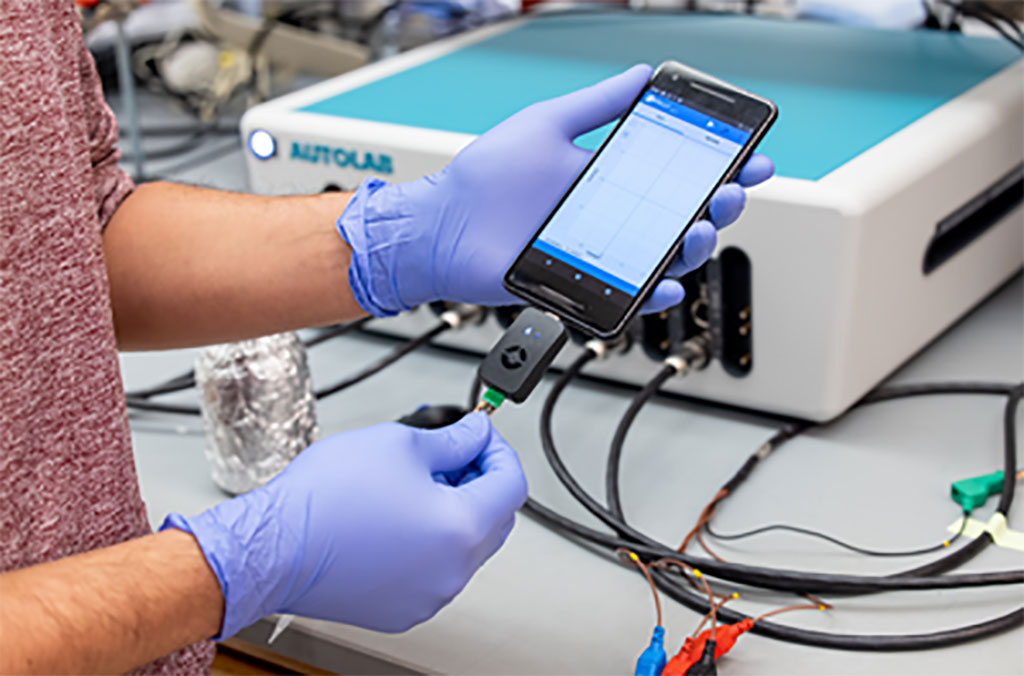Rapid COVID-19 Diagnostic Test Delivers Results with 90% Accuracy within Four Minutes
By LabMedica International staff writers
Posted on 13 May 2021
A low-cost, rapid diagnostic test for COVID-19 that provides results within four minutes with 90% accuracy could extend reliable testing for SARS-CoV-2 to remote and disadvantaged areas.Posted on 13 May 2021
Developed by researchers at Penn Medicine (Philadelphia, PA, USA), the fast and inexpensive diagnostic test, called RAPID 1.0 (Real-time Accurate Portable Impedimetric Detection prototype 1.0), is inexpensive and highly scalable in comparison to existing methods for COVID-19 detection, allowing the production of millions of units per week.

Image: RAPID, a low-cost COVID-19 diagnostic test, can detect SARS-CoV-2 within four minutes with 90 percent accuracy (Photo courtesy of Penn Medicine)
Despite the urgency of the pandemic, most available methods for COVID-19 testing use RT-PCR - reverse transcription polymerase chain reaction - to detect SARS-CoV-2. Though effective, the technique requires large laboratory space and trained workers to employ. These tests are also costly, they run a risk of cross-contamination, and can take hours or days to provide results. RAPID has been developed to quickly and accurately detect the virus while remaining cheap enough to be widely accessible. An electrode printed using a screen printer - thousands of which can be printed in a day at very low cost - can detect the virus in nasal swab or saliva samples. The results can be read on a benchtop instrument or on a smartphone.
The RAPID technology uses electrochemical impedance spectroscopy (EIS), which transforms the binding event between the SARS-CoV-2 viral spike protein and its receptor in the human body, the protein ACE2 (which provides the entry point for the coronavirus to hook into and infect human cells), into an electrical signal that clinicians and technicians can detect. That signal allows the test to discriminate between infected and healthy human samples. The signal can be read through a desktop instrument or a smartphone.
The team assessed the performance of RAPID using both COVID-19 positive and negative clinical samples, including samples of the highly contagious UK B117 variant. In blinded tests, they analyzed 139 nasal swab samples - 109 of which were COVID-19 positive and 30 COVID-19 negative, as determined by standard RT-PCR clinical assessments. The team also analyzed 50 saliva samples from patients. For the nasal swab samples, RAPID was 87.1% accurate. For saliva samples, RAPID was 90% accurate.
RAPID provides results in four minutes, which is faster than most methods currently available for diagnosing COVID-19. For example, serological tests can take around 15 to 20 minutes, and they are about 60 to 70% accurate. In addition, RAPID is able to detect COVID-19 at extremely low concentrations (1.16 PFU mL), which corresponds to a viral load that correlates with the initial stages of COVID-19 (about two to three days after onset of symptoms). This is beneficial for detecting individuals at the earliest stages of infection, allowing for rapid care and the potential decrease of further viral spread.
Importantly, the technology is affordable and scalable. Each test, which can be performed at room temperature, costs USD 4.67 to produce. Additionally, the electrodes used in the test can be quickly mass-produced using commercially available screen-printers to print the circuit board (named eChip). One laboratory-sized unit is able to produce 35,000 electrodes daily (about 1.05 million per month). The team also constructed an electrode for RAPID composed of filter paper, which is a more accessible and inexpensive material. Named ePAD, the researchers demonstrated the applicability of ePAD for RAPID in a portable method, connected to a smart device, which may enable further scale and on-demand testing capabilities at the point-of-care. Though RAPID was developed as a COVID-19 test, the technology can be used to detect other viruses and diagnose a variety of diseases such as the flu or sexually transmitted diseases.
“Quick and reliable tests like RAPID allow for high-frequency testing, which can help identify asymptomatic individuals who, once they learn they are infected, will stay home and decrease spread. We envision this type of test being able to be used at high-populated locations such as schools, airports, stadiums, companies - or even in one’s own home,” said first author Marcelo Der Torossian Torres, PhD, a postdoctoral researcher at Penn.
Related Links:
Penn Medicine













